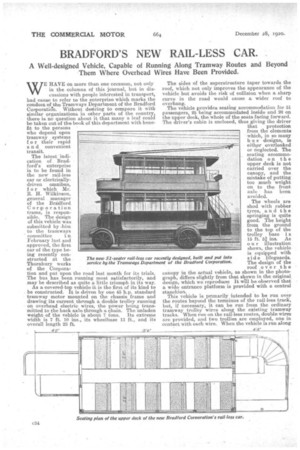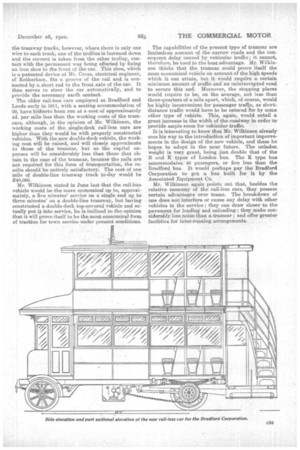BRADFORD'S NEW RAIL-LESS CAR. .
Page 20

Page 21

If you've noticed an error in this article please click here to report it so we can fix it.
A Well-designed Vehicle, Capable of Running Along Tramway Routes and Beyond Them Where Overhead Wires Have Been Provided.
WE HAVE on more than one occasion, not only in the columns of this journal, but in discussions with people interested in transport, had cause to refer to the enterprise which marks the conduct of the Tramways Department of the Bradford Corporatien. Without desiring to compare it with similar organizations in other parts of the country, there is no question about it that many a leaf could be taken out of the book of this department with benefit to the persons who depend upon tramway systems i.e r their rapid a n d convenient transit.
The latest indication of Bradford's enterprise is to be found in the new rail-less car or electricallydriven omnibus, for which Mr. R. H. Wilkinson, general manager of the Bradford Corporation trams, is responsible. The design of this vehicle was submitted by .him to the tramways committee i n February last and approved, the first car of the type being recently constructed at the Thornbury works of the Corporation and put upon the road last month for its trials. The bus has been running most satisfactorily, and may be described as quite a little triumph in its way. As a covered-top vehiclei it is the first. of its kind to be constructed. It is driven by one 45 h.p. standard tramway motor mounted on the chassis frame and drawing its current through a double trolley running on overhead alectrie wires, the power being transmitted to the back axle through a, chain. The unladen weight of the vehicle is about 7 tons. Its extreme width is 7 ft. 10 ins., its wheelbase 13 ft., and its overall length 23 ft. The new 52-seater rail-less car re eat of the Bradford Corporation. The sides of the superstructure taper towards the roof, which not only improves the appearance of the vehicle but avoids the risk of collision when a sharp curve in the road would cause a wider roof to overhang.
The vehicle provides seating accommodation for 61 passengers, 25 being accommodated inside and 26 on the upper deck, the whole of the seats facing forward. The driver's cabin is enclosed, thus giving the driver that protection from the elements which, in so many b u s designs, is either overlooked or neglected. The seating accommodation on the upper deck is not carried over the canopy, and the mistake of putting too much weight on to the front axle • has been avoided.
The wheels are shod with rubber tyres, and the springing is quite good. The height from the ground to the top of the trolley base is 15 ft. 61 ins. As o u r illustration shows, the vehicle is equipped with side lifeguards. The design of the roof over the canopy in the actual vehicle, as shown in the photograph, differs slightly from that shown in the original design, which we reproduce e It will be observed that a wide entrance platform is provided with a central stanchion. •
This vehicle is primarily intended to be run over the routes beyond the terminus of the rail-less track, but, if necessary, it can be run from the ordinary tramway trolley wires along the existing tramway tracks. When run on the rail-less routes, double wires are provided, and two trollies are employed, one in contact with each wire. When the vehicle is run along the tramway tracks, however, where there is only one wire to each track, one of the trollies is fastened down and the current is taken from the other trolley, contact with the permanent way being effected by fixing an iron shoe to the front of the car. This shoe, which is a patented device of Mr. Cross, electrical engineer, of Rotherham, fits a groove of the rail and is connected by a short rod to the front axle of the car. It thus serves to steer the car automatically, and to provide the necessary earth contact.
The older rail-leas ears employed at Bradford and Leeds early in 1911, with a seating accommodation of 29, have hitherto been run at a cost of approximately 4d. per mile less than the working costs of the tramcars, although, in the opinion of Mr. Wilkinson, the working costs of the, single-deck rail-less ears are higher than they would be with properly constructed vehicles. With the new double-deck vehicle, the working cost will be raised, and will closely approximate to those of the tramcar, but as the capital expenses will be considerably less than those that obtain in the case of the tramcar, because the rails are not required for this form of transportation, the results should be entirely satisfactory. The cost of one mile of double-line tramway track to-day would be 140,000.
Mr. Wilkinson stated in June last that the rail-less vehicle would be the more economical up to, approximately, a five minutes' service on a single end up to three minutes' on a double-line tramway, but having constructed a double-deck top-covered vehicle and actually put ik into service, he is inclined to the opinion that it will prove itself to be the most economical farm of traction for town service under present conditions. The capabilities of the present type of tramcar are limitethon account of the narrow roads and the consequent delay caused by vehicular traffic; it cannot, therefore, be Used to the best advantage. Mr. Wilkinson thinks that the tramcar could prove itself the most economical vehicle on account of the high Speeds which it can attain, but it would require a. certain minimum amount of traffic and air uninterrupted road to secure this end. Moreover, the stopping places would require to be, on the average, not less than three-quarters of a mile apart, which, of course, would be highly inconvenient for passenger traffic as shortdistance traffic would have to be catered for by some other type of vehicle. This, again would entail a great increase in the width of the roadway in order to provide ample room for vehicular traffic.
It is interesting to know that Mr. Wilkinson already sees his way to the introduction of important improvements in the design of the new vehicle, and these he hopes to adopt in the near future. The unladen weight is very great, being just double that of the B and K types of London bus. The K type bus accommodates 46 pasengers, or five less than the Bradford bus. It would perhaps pay the Bradford Corporation to get a bus built for it by the Associated Equipment Co.
Mr. Wilkinson again points out that, besides the relative economy of the rail-less cars, they possess certain advantages over trains. The breakdown of one does not interfere or cause any delay with other vehicles in the service ; they can draw closer to the pavement for loading and unloading ; they make considerably less noise than a. tramcar; and offer greater facilities for inter-running arrangements.






























